Châteauneuf-du-Pape Dials Back to Find Its Balance and Nuance: Nine Top Producers’ 2018 Wines Show (9-Bottle Pack $499) + Pure Châteauneuf-du-Pape (4-Bottle Pack $699) + SATURDAY SIPS
Wine is evolution. The flavors behind that simple metaphor are as vast as any spectrum; it can be seen in grape vines aging gracefully, producing fruit that is increasingly concentrated and complex—it is obvious when a vigneron hones the craft of winemaking and produces better and better wines, even in challenging vintages. And of course, it is seen most profoundly inside the bottle itself, where subtle, inexorable changes occur in certain wines under controlled oxidation; bottle bouquet and polymeric pigment changes are among the most satisfying notes that mature wine offers.
But the concept of evolution may also apply to an entire appellation, and nowhere is the relatively rapid rise, fall, and rebirth of a style more evident than in Châteauneuf-du-Pape. Throughout much of its history, CdP proved a leathery foil to the potent and somewhat austere elegance of Bordeaux and the heady sensuousness of Burgundy by producing ‘southern wines’ of rustic complexity—brawny, earthy and beautiful. But as a business, wine finds itself beholden to trends, since moving product is necessary to remain afloat; during the Dark Ages (roughly 1990 through 2010—in part influenced by the preferences of powerful critic Robert Parker Jr.) much of Châteauneuf-du-Pape’s output became bandwagon wines, jammy and alcoholic, lacking structure and acids, in the process becoming more polished than rustic, more lush than nuanced. For some, this was delightful; for others, it was a betrayal of heritage and terroir.
Yet a new generation of southern Rhône winemakers (notably Jean-Paul Daumen, Thierry and Jean-Pierre Usseglio and Isabel Ferrando) seems to have identified the problem and corrected it. Recent vintages—2018 in particular—have seen the re-emergence of the classic, balanced style Châteauneuf-du-Pape, albeit at slightly higher prices. A changing climate has also altered traditional blends, so that more Mourvèdre may be found in cuvées that were once nearly all Grenache; Mourvèdre tends to have less sugar, and so produces wine less alcoholic and jammy, adding back some of the herbal qualities once so highly prized in the appellation. But a return to old school technique has also helped; many of the wines in this package were not destemmed prior to crushing and most were fermented on native yeast rather than cultured yeast.
If you survived the Fruit-Bomb era begrudgingly, you will no doubt welcome the return to the future that has begun to again take hold in Châteauneuf-du-Pape, in many ways, completing a cycle.

Châteauneuf-du-Pape 2018 Report:
A Rainy, Then Hot, Then Dry … Year Brings Richness and Balance
Châteauneuf-du-Pape is an aggressively blended cornucopia; the reality of permitting so many grape varieties in a wine that a given vintage may favor one grape at the expense of others. Most vintage reports focus on Grenache, the variety upon which CdP has (historically) staked its reputation, but the trend in local vintages has been a changing climate which more and more frequently interrupts the early-budding Grenache with frost and later, with excessive springtime rain, leading to a greater percentage of Syrah and Mourvèdre to represent the blend. Such wines tend to be lower in alcohol with a flavor profile leaning toward darker fruits and earthy minerality, so if that is the style of Châteauneuf-du-Pape you prefer, 2018 was your ideal vintage. Heavy rains in May and June caused a poor fruit set for Grenache and many growers reported a 40%-60% reduction; Syrah and Mourvèdre fared better and are pronounced in the cuvées.
This package, with nine bottles ($499), contains one bottle of each from the following CdP’s most highly regarded growers in addition to a bottle of the Saturday Sipes featured wine. A second package of four cuvées at $699 show the singular expression of Châteauneuf-du-Pape at its zenith.
Domaine de La Vieille Julienne
Jean-Paul Daumen is the 5th generation of his family to manage Vieille Julienne, and as a winemaker, he is a bit of an iconoclast. Having switched to biodynamics upon taking over the estate in 1990, he abandoned the use of all herbicides, fungicides, fertilizers and all unnatural additions including cultured yeasts. Referring to his farming method as ‘holistic’, he says, “Climatic conditions—the sun, atmospheric pressure, the effects of the moon and the planets, are some of the parameters that seem obvious to take into consideration.” He describes the terrior of Vieille Julienne as ‘soils that remain after the Rhône, which was once a torrential river that covered the entire river delta of Provence, receded.’ “There is a large amount of calcium in the earth that is sometimes overlooked when you see pictures of the alluvial quartzite galets in the vineyards.”
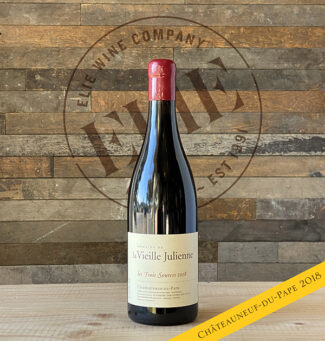 Domaine de La Vieille Julienne ‘Trois Sources’, Châteauneuf-du-Pape ($72) s from a single bloc of 21 acres in the northernmost section of Châteauneuf-du-Pape; the vineyard shares its bounty with ‘les Hauts-lieux’, although ‘Trois Sources’ is more fruit forward than the Hauts-Lieux cuvée; black currant, black licorice, violets, and some salty minerality behind pure, polished tannins.
Domaine de La Vieille Julienne ‘Trois Sources’, Châteauneuf-du-Pape ($72) s from a single bloc of 21 acres in the northernmost section of Châteauneuf-du-Pape; the vineyard shares its bounty with ‘les Hauts-lieux’, although ‘Trois Sources’ is more fruit forward than the Hauts-Lieux cuvée; black currant, black licorice, violets, and some salty minerality behind pure, polished tannins.
Domaine Charvin
Established in 1851, Domaine Charvin currently owned and operated by Laurent, the sixth-generation Charvin to run the Domaine, but he is the first to commercially market a proprietary bottling. His meticulous attention to detail sees his harvest entirely hand-picked and sorted, and bottled without filtration. Charvin produces only a single cuvée of Châteauneuf-du-Pape which is consistently rated highly; it’s drawn from a 20-acre plot composed of vines whose average age is over fifty years, mostly planted on sandy, north-facing slopes.
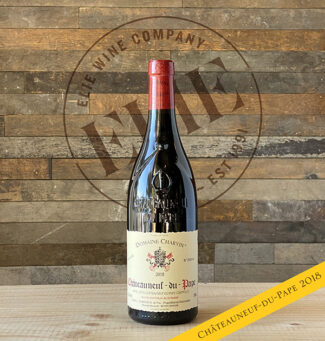 Domaine Charvin, Châteauneuf-du-Pape ($61)is 85% Grenache, 5% Mourvèdre, 5% Vaccarèse, 5% Syrah; for the record, Vaccarèse is one of the rarest grapes in Châteauneuf-du-Pape, with just over 10 acres planted in total and little more grown elsewhere. It contributes notes of pine forest and minty juniper to the wine, which shows brawny boysenberry jelly concentrated by hints of allspice and bitter chocolate. 2500 cases produced.
Domaine Charvin, Châteauneuf-du-Pape ($61)is 85% Grenache, 5% Mourvèdre, 5% Vaccarèse, 5% Syrah; for the record, Vaccarèse is one of the rarest grapes in Châteauneuf-du-Pape, with just over 10 acres planted in total and little more grown elsewhere. It contributes notes of pine forest and minty juniper to the wine, which shows brawny boysenberry jelly concentrated by hints of allspice and bitter chocolate. 2500 cases produced.
Domaine Santa Duc
At the foot of the Dentelles de Montmirail, six generations of the family Gras have succeeded each other at the helm of Santa Duc; since the 2017 vintage, Benjamin Gras claims the honor, and with it, inherits a tradition of massal selections, biodynamics, whole cluster vinification, fermentation with wild yeasts, minimum intervention and non-filtered wines. “We produce terroir wines,” he explains, “and biodynamics is the best tool—it allows you to bring microorganisms directly into the soil.” Mirroring the re-emergence of the more nuanced style of Châteauneuf-du-Pape, he calls winemaking ‘an evolution’. “Each year I have to ask myself questions in how to produce better wine. We shortened the maceration so there is less extraction in the cellar—I try to do nothing to degrade the quality of the grape itself.”
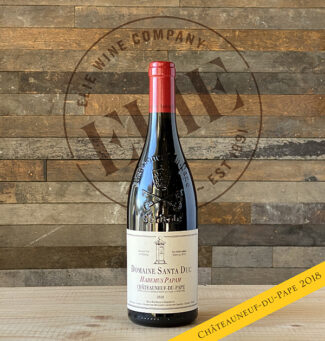 Domaine Santa Duc ‘Habemus Papam’, Châteauneuf-du-Pape ($54)comes from small plots (less than five acres total) found at Le Pradel and La Font du Pape, to the east and center of Châteauneuf-du-Pape, where the soils are rich in sandy clay on the surface with calcareous subsoils beneath. 70% Grenache, it is 30% Syrah—La Font du Pape translates to ‘a place where water is to be found’, ideal for Syrah to express fresh crispness and shows plum compote, the signature garrigue aromatics of Southern Rhône, toasted spices and a marvelous balance of floral delicacy and taut CdP strength.
Domaine Santa Duc ‘Habemus Papam’, Châteauneuf-du-Pape ($54)comes from small plots (less than five acres total) found at Le Pradel and La Font du Pape, to the east and center of Châteauneuf-du-Pape, where the soils are rich in sandy clay on the surface with calcareous subsoils beneath. 70% Grenache, it is 30% Syrah—La Font du Pape translates to ‘a place where water is to be found’, ideal for Syrah to express fresh crispness and shows plum compote, the signature garrigue aromatics of Southern Rhône, toasted spices and a marvelous balance of floral delicacy and taut CdP strength.
Domaine de Beaurenard
A family-run estate for eight generations, brothers Daniel & Frédéric Coulon and Daniel’s sons Victor and Antonin carry forward the torch amid a mosaic of limestone, round pebbles on a clay substrate with varying amounts of iron and fine sedimentary sand. There are 13 legally permitted varieties in Châteauneuf-du-Pape, and Beaurenard grows them all. After allowing a specific plot to remain fallow for twelve years, the Coulons splice-grafted each allowable grape variety chosen from the estate’s oldest vines and created a Conservatory: “Our primary goal was to safeguard the natural genetic heritage that is particularly well adapted to the terroir. But we were also mindful of future generations, and if global warning continues, to increase the proportion of varieties that contain less sugar and contribute aromatic complexity.”
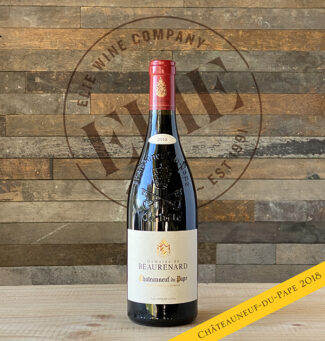 Domaine de Beaurenard, Châteauneuf-du-Pape ($62) , although primarily Grenache, does indeed contain all thirteen allowable grape varieties. Hand-picked and sorted in the vineyard, co-fermented and vatted for an extended period for soft extraction. The estate’s flagship wine is expressive and bold, displaying bright cherry cola and raspberry jam flavors with smoke, earth, espresso, wild mushroom and an elegant and lively finish laced with ripe tannins.
Domaine de Beaurenard, Châteauneuf-du-Pape ($62) , although primarily Grenache, does indeed contain all thirteen allowable grape varieties. Hand-picked and sorted in the vineyard, co-fermented and vatted for an extended period for soft extraction. The estate’s flagship wine is expressive and bold, displaying bright cherry cola and raspberry jam flavors with smoke, earth, espresso, wild mushroom and an elegant and lively finish laced with ripe tannins.
Domaine Pierre Usseglio
New by Châteauneuf standards, Pierre Usseglio was founded in 1948 by Italian émigré Pierre Usseglio. In 1998, he turned over the operations to his sons Thierry and Jean-Pierre Usseglio, who now balance their time between the cellar and the vineyard. Of the estate’s hundred acres, about sixty are planted to Châteauneuf-du-Pape red varieties, the rest to Châteauneuf-du-Pape white, Lirac red, Côtes-du-Rhône and Vin de France.
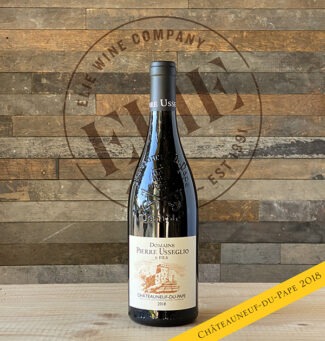 Domaine Pierre Usseglio, Châteauneuf-du-Pape ($49) is 55% Grenache, 25% Syrah, 15% Mourvèdre and 5% Cinsault displays the purity of the domain’s terroir with classic scents of sun-warmed stones, black cherries, graphite and anise accented wood spice; a solid tannic grip and energy for cellaring.
Domaine Pierre Usseglio, Châteauneuf-du-Pape ($49) is 55% Grenache, 25% Syrah, 15% Mourvèdre and 5% Cinsault displays the purity of the domain’s terroir with classic scents of sun-warmed stones, black cherries, graphite and anise accented wood spice; a solid tannic grip and energy for cellaring.
Domaine La Barroche
In the Châteauneuf-du-Pape, there is old, there is very old, and there is Domaine La Barroche, which has been in the same family since the 14th century—it is currently managed by the sister and brother team of Laetitia and Julien Barrot. The vines themselves lay a similar claim to gravitas; at over 100 years of age, the estate’s Grenache plantings are among the oldest in the appellation. At around 30 acres, La Barroche is a comfortably small parcel that ensures rigorous bud pruning, green harvesting, and leaf thinning; up until 2002, when the siblings took over, all the grapes were sold to négociants. And so, in an ancient holding, Julien and Laetitia have taken their father’s work to the next level, moving to estate bottlings of organic agriculture, vinifying each grape variety (and some parcels) separately, studying and learning as they go.
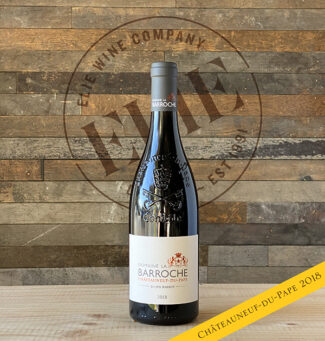 Domaine La Barroche ‘Signature’, Châteauneuf-du-Pape ($45) The blend is 60% Grenache, 19% Mourvèdre and a balanced mix of other permitted varieties, all grown in the red clay and yellow sands typical of the region; the wine is full-bodied and generously sumptuous, with sweet black raspberry notes above seascape herbs (tarragon and thyme) and velvety mocha at the finish.
Domaine La Barroche ‘Signature’, Châteauneuf-du-Pape ($45) The blend is 60% Grenache, 19% Mourvèdre and a balanced mix of other permitted varieties, all grown in the red clay and yellow sands typical of the region; the wine is full-bodied and generously sumptuous, with sweet black raspberry notes above seascape herbs (tarragon and thyme) and velvety mocha at the finish.
Domaine Saint Préfert
Isabel Ferrando is the force behind Saint Préfert, and one of the most respected winemakers in France; her reputation has grown every vintage since her first release in 2003. From the 55-acre estate in the south of CdP, she produces five cuvées, two whites and three reds. The vines are old, but her team is young and she is always open to new ideas; she relies on tradition without being trapped by it. For example, she has taken to Stockinger as a supplier of oak for maturation, claiming that the Austrian cooperage results in more tension in the wines. In the 2009 vintage, Ferrando started working with whole-cluster fermentation without added yeasts, and discovered that this magnified freshness in the wines. “In ten years,” she maintains, “I’ve progressed. My sensitivity to the terroir is much more pronounced.”
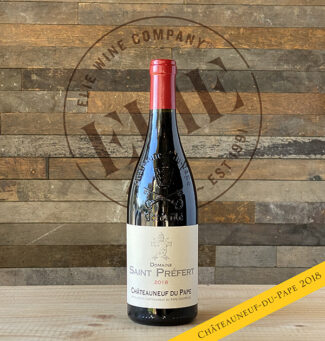 Domaine Saint Préfert ‘Classique’, Châteauneuf-du-Pape ($52) is 85% Grenache and 5% each of Syrah, Mourvèdre, and Cinsault; a beautifully perfumed and nuanced wine with classic notes of strawberries, cherries, loam, earth and dried flowers, polished, elegant and silky on the palate.
Domaine Saint Préfert ‘Classique’, Châteauneuf-du-Pape ($52) is 85% Grenache and 5% each of Syrah, Mourvèdre, and Cinsault; a beautifully perfumed and nuanced wine with classic notes of strawberries, cherries, loam, earth and dried flowers, polished, elegant and silky on the palate.
Domaine du Vieux Télégraphe
Châteauneuf-du-Pape is perhaps the most celebrated AOP in southern Rhône, and La Crau is arguably Châteauneuf-du-Pape’s grandest cru. The Brunier family has been a fixture on the plateau of La Crau since the late nineteenth century, when Hippolyte Brunier made wine from a couple acres of land. His vineyard was not only small, but it was on one the highest, most inhospitable terrains between Châteauneuf-du-Pape and Bédarrides—the elevation had prompted the construction of a communication tower century ago to transmit between Marseille and Paris, and hence, the winery’s name. But lousy ground often creates superb wine, and it so happened that the reputation of his tiny, barren parcel of galets roulés—rounded stones—traveled faster than a telegraph message, and Brunier gradually expanded his holdings. Today, the assemblage that bears the name of the flagship wine is made exclusively from the estate’s older vines; fruit produced by younger vines end up in Vieux Télégraphe’s second label, ‘Télégramme’.
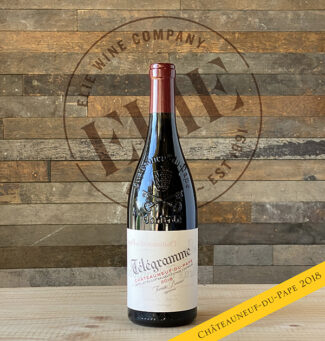 Domaine du Vieux Télégraphe ‘Télégramme’, Châteauneuf-du-Pape ($49)80% Grenache, 10% Syrah, 6% Mourvèdre, 4% Cinsault. Juicy and robust, the fruit profile is generous with layers of blueberry, ripe cherry compote and cassis tinged with smoke and finishing with supple, structured tannins.
Domaine du Vieux Télégraphe ‘Télégramme’, Châteauneuf-du-Pape ($49)80% Grenache, 10% Syrah, 6% Mourvèdre, 4% Cinsault. Juicy and robust, the fruit profile is generous with layers of blueberry, ripe cherry compote and cassis tinged with smoke and finishing with supple, structured tannins.
Very Old Vines, Low Yields, Natural Approach:
Pure Châteauneuf-du-Pape (4-Bottle Pack $699)
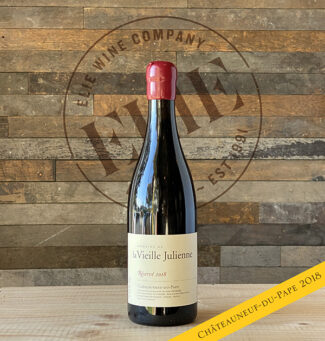 Domaine de La Vieille Julienne ‘Réservé’ ($312)Exclusively from more than a hundred-year old vines of Grenache (90%), Syrah, Cinsault and Counoise, and vinified separately. A wine with extraordinary concentration and sublime freshness; rich and sappy with sweet red berry preserve and candied lavender notes shored by black licorice, smoky earth, with sheets of glossy, ripe and perfectly integrated tannins behind seamless acidity.
Domaine de La Vieille Julienne ‘Réservé’ ($312)Exclusively from more than a hundred-year old vines of Grenache (90%), Syrah, Cinsault and Counoise, and vinified separately. A wine with extraordinary concentration and sublime freshness; rich and sappy with sweet red berry preserve and candied lavender notes shored by black licorice, smoky earth, with sheets of glossy, ripe and perfectly integrated tannins behind seamless acidity.
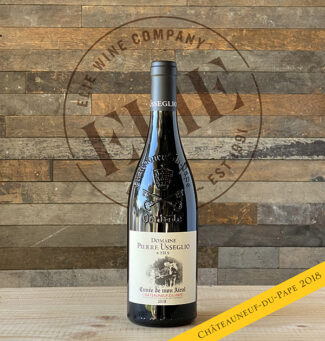 Domaine Pierre Usseglio ‘Cuvée de Mon Aïeul’ ($112)Pure Grenache from 75 to 90-year-old vines in select parcels in Lieux-dits La Crau, Les Bédines and Les Serres. An expansive, complex bouquet with layers of cherry liqueur, exotic incense and dried spices; the warm fruit resolves into cooling graphite and an opulent finish without hard edges. 100% Grenache.
Domaine Pierre Usseglio ‘Cuvée de Mon Aïeul’ ($112)Pure Grenache from 75 to 90-year-old vines in select parcels in Lieux-dits La Crau, Les Bédines and Les Serres. An expansive, complex bouquet with layers of cherry liqueur, exotic incense and dried spices; the warm fruit resolves into cooling graphite and an opulent finish without hard edges. 100% Grenache.
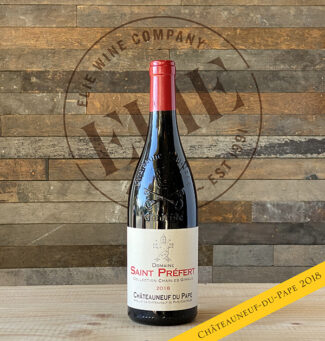 Domaine Saint Préfert ‘Collection Charles Giraud’ ($160) 60% Grenache and 40% Mourvèdre from 80-year-old vines, the wine is voluptuous and penetrating with aromas of peppery garrigue, smoked meats, blackcurrants, opulent, piercing and honed with feathery tannins and an undertow of fresh acidity. 100% Grenache.
Domaine Saint Préfert ‘Collection Charles Giraud’ ($160) 60% Grenache and 40% Mourvèdre from 80-year-old vines, the wine is voluptuous and penetrating with aromas of peppery garrigue, smoked meats, blackcurrants, opulent, piercing and honed with feathery tannins and an undertow of fresh acidity. 100% Grenache.
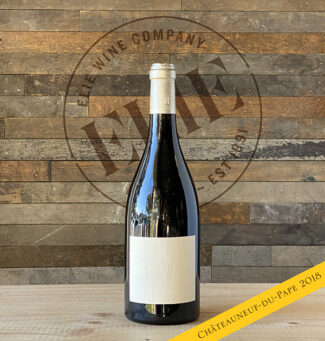 Domaine La Barroche ‘Pure’, Châteauneuf-du-Pape ($128) From century-old Grenache vines deeply rooted in a single parcel with sandy and red Comtat sandstone soil the 2018 cuvée ‘Pure’ is a full-bodied beauty. Fully ripe, boasting notes of black cherries, wild herbs and hints of dark chocolate, it nevertheless comes across as silky and almost airy on the palate, while showing real intensity and length on the licorice-tinged finish.
Domaine La Barroche ‘Pure’, Châteauneuf-du-Pape ($128) From century-old Grenache vines deeply rooted in a single parcel with sandy and red Comtat sandstone soil the 2018 cuvée ‘Pure’ is a full-bodied beauty. Fully ripe, boasting notes of black cherries, wild herbs and hints of dark chocolate, it nevertheless comes across as silky and almost airy on the palate, while showing real intensity and length on the licorice-tinged finish.

Château de la Font du Loup ‘Le Puy Rolland – Vieilles Vignes’, Châteauneuf-du-Pape 2018
Long name, old vines: Anne-Charlotte Mélia-Bachas crafts her CdP at La Font du Loup from centenarian-plus vines planted in cool, high-elevation sandy soils on a north-facing plot directly behind La Crau; the result is a wine that is as elegant and pure as it is complex. Made of 100% Grenache, it showcases the variety’s characteristic spicy fruit. Only 500 cases were made of this vintage. ($55)
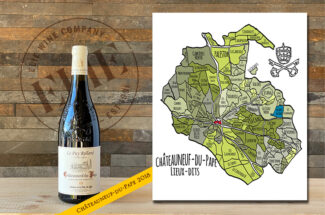
As always, we are committed to conduct the tasting in the safest way possible. We will provide glasses, but highly encourage guests to bring their own.
- - -
Posted on 2021.10.16 in Châteauneuf-du-Pape, France, Wine-Aid Packages, Southern Rhone
Featured Wines
- Notebook: A’Boudt Town
- Saturday Sips Wines
- Saturday Sips Review Club
- The Champagne Society
- Wine-Aid Packages
Wine Regions
Grape Varieties
Aglianico, Albarino, Albarín Blanco, Albarín Tinto, Albillo, Aleatico, Arbanne, Aubun, Barbarossa, barbera, Beaune, Biancu Gentile, bourboulenc, Cabernet Franc, Cabernet Sauvignon, Caino, Caladoc, Calvi, Carcajolu-Neru, Carignan, Chablis, Chardonnay, Chasselas, Clairette, Corvina, Cot, Counoise, Erbamat, Ferrol, Fiano, Frappato, Friulano, Fromenteau, Fumin, Garnacha, Gewurztraminer, Godello, Graciano, Grenache, Grolleau, Groppello, Juan Garcia, Lambrusco, Loureira, Macabeo, Macabou, Malvasia, Malvasia Nera, Marsanne, Marselan, Marzemino, Melon de Bourgogne, Merlot, Mondeuse, Montanaccia, Montepulciano, Morescola, Morescono, Moscatell, Muscadelle, Muscat, Natural, Nero d'Avola, Parellada, Patrimonio, Petit Meslier, Petit Verdot, Pineau d'Aunis, Pinot Auxerrois, Pinot Blanc, Pinot Gris, Pinot Meunier, Pinot Noir, Poulsard, Prieto Picudo, Rondinella, Rousanne, Roussanne, Sangiovese, Sauvignon Blanc, Savignin, Semillon, Souson, Sparkling, Sumoll, Sylvaner, Syrah, Tannat, Tempranillo, Trebbiano, Trebbiano Valtenesi, Treixadura, Trousseau, Ugni Blanc, vaccarèse, Verdicchio, Vermentino, Viognier, Viura, Xarel-loWines & Events by Date
- April 2024
- March 2024
- February 2024
- January 2024
- December 2023
- November 2023
- October 2023
- September 2023
- August 2023
- July 2023
- June 2023
- May 2023
- April 2023
- March 2023
- February 2023
- January 2023
- December 2022
- November 2022
- October 2022
- September 2022
- August 2022
- July 2022
- June 2022
- May 2022
- April 2022
- March 2022
- February 2022
- January 2022
- December 2021
- November 2021
- October 2021
- September 2021
- August 2021
- July 2021
- June 2021
- May 2021
- April 2021
- March 2021
- February 2021
- January 2021
- December 2020
- November 2020
- October 2020
- September 2020
- August 2020
- July 2020
- June 2020
- May 2020
- April 2020
- March 2020
- February 2020
- January 2020
- December 2019
- November 2019
- October 2019
- September 2019
- August 2019
- July 2019
- June 2019
- May 2019
- April 2019
- March 2019
- February 2019
- January 2019
- December 2018
- November 2018
- October 2018
- September 2018
- August 2018
- July 2018
- June 2018
- May 2018
- April 2018
- March 2018
- February 2018
- January 2018
- December 2017
- November 2017
- October 2017
- September 2017
- August 2017
- July 2017
- June 2017
- May 2017
- April 2017
- March 2017
- February 2017
- January 2017
- December 2016
- November 2016
- October 2016
- September 2016
- August 2016
- July 2016
- June 2016
- May 2016
- April 2016
- March 2016
- February 2016
- January 2016
- December 2015
- November 2015
- October 2015
- September 2015
- August 2015
- July 2015
- June 2015
- May 2015
- April 2015
- March 2015
- February 2015
- January 2015
- December 2014
- November 2014
- October 2014
- September 2014
- August 2014
- July 2014
- June 2014
- April 2014
- March 2014
- February 2014
- January 2014
- December 2013
- November 2013
- October 2013
- September 2013
- August 2013
- July 2013
- June 2013
- May 2013
- April 2013
- March 2013
- February 2013
- January 2013
- December 2012
- November 2012
- October 2012
- February 2004
Search



